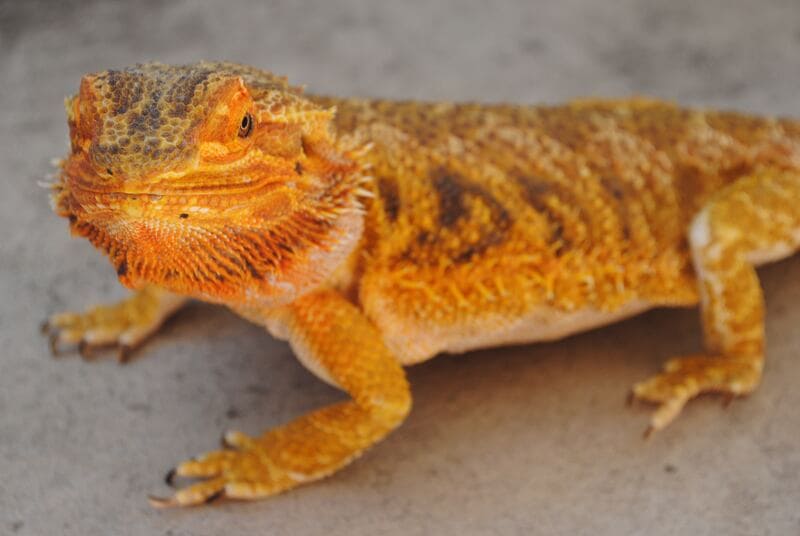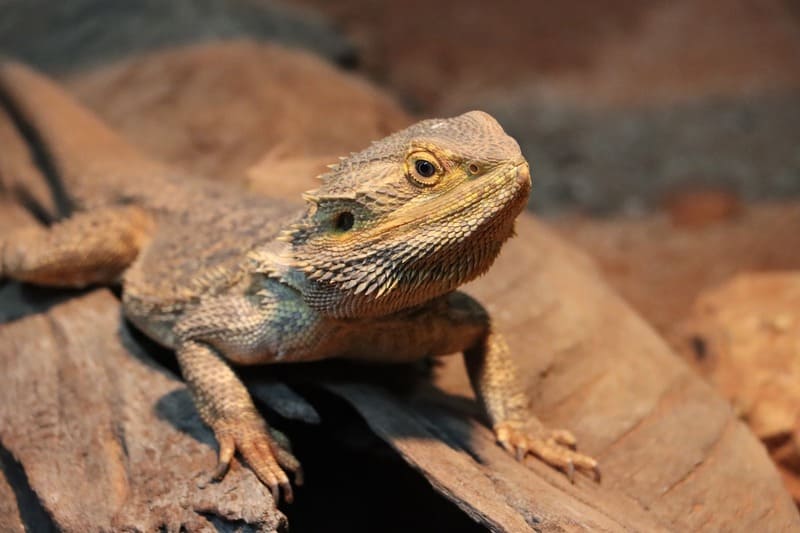Bearded dragons have gained immense popularity as exotic pets in recent years. Their gentle demeanor, unique appearance, and relatively low maintenance requirements make them a top choice for reptile enthusiasts. However, one question that often arises, especially among those new to the world of herpetology, is whether bearded dragons are poisonous or carry any potential health risks to humans. In this comprehensive exploration of the topic, we will delve into the biology of bearded dragons, their behavior, and address the question of their toxicity.

Introduction to Bearded Dragons
Bearded dragons are native to the arid and semi-arid regions of Australia. They belong to the family Agamidae and are a type of lizard known as agamids. These reptiles are famous for their distinctive appearance, characterized by spiky scales under their throats that they can puff out to create a “beard,” hence their name.
Bearded dragons are relatively small in size compared to other reptile species, with adults typically reaching lengths of 12-24 inches (30-61 cm) from head to tail. They have a sturdy body, a triangular-shaped head, and a long, slender tail. These lizards are diurnal, meaning they are active during the day and rest at night.
In the wild, bearded dragons are omnivorous, feeding on a varied diet of insects, small vertebrates, and plant matter. In captivity, their diet should replicate this diversity to ensure they receive the necessary nutrients to thrive.
Are Bearded Dragons Venomous or Poisonous?
Bearded dragons are not venomous or poisonous. They do not possess venom glands, fangs, or any specialized structures that would allow them to inject venom into their prey or potential predators. This distinction is crucial, as venomous animals, like some snakes, spiders, and certain types of lizards, can deliver venom through bites or stings, which can be harmful or even lethal to humans.
While bearded dragons lack venom, they do have some fascinating defense mechanisms that might be mistaken for venomous traits. One of these defense mechanisms is the display of their beard. When a bearded dragon feels threatened or stressed, it can puff out the spiky scales under its throat, making it appear larger and more intimidating to potential predators or threats. This display is often accompanied by other defensive behaviors like hissing and agitated body movements.
In addition to their beard display, bearded dragons may use their sharp teeth to bite if they feel cornered or threatened. While their bites can be painful and result in minor skin damage, these lizards are not capable of injecting venom into their victims. The primary purpose of these behaviors is to deter predators or perceived threats and avoid confrontation.
So, while bearded dragons have ways to defend themselves and deter potential threats, their defense mechanisms are not associated with venom or poison and do not pose any risk of toxicity to humans.
Handling Bearded Dragons Safely
Bearded dragons are known for their docile and friendly nature, making them excellent pets for both beginners and experienced reptile enthusiasts. When handled with care and respect, these lizards are generally very tolerant of human interaction. However, it’s crucial to handle them correctly to ensure both your safety and the well-being of the bearded dragon.
Here are some guidelines for safe bearded dragon handling:
1. Wash Your Hands: Before and after handling your bearded dragon, make sure to wash your hands thoroughly with soap and water. This helps prevent the transmission of any potential harmful bacteria from the lizard to you and vice versa.
2. Approach Slowly: When you want to handle your bearded dragon, approach it slowly and avoid sudden movements. Quick and unexpected actions can startle the lizard, leading to defensive behaviors.
3. Support Their Body: When picking up your bearded dragon, support its entire body with your hands. Be gentle and avoid squeezing or putting excessive pressure on its body or limbs.
4. Avoid Grabbing the Tail: While bearded dragons can drop their tails as a defense mechanism, it is a stressful and painful experience for them. Avoid grabbing the tail, as it can lead to tail loss.
5. Respect Their Personal Space: Pay attention to your bearded dragon’s body language. If it displays signs of stress or agitation, such as darkening of the beard, hissing, or agitated movements, give it some space and time to calm down before attempting to handle it.
6. Supervise Interaction with Children: If children are handling the bearded dragon, make sure they are gentle and supervised to prevent any accidental harm to the lizard.
7. Don’t Handle Too Frequently: While it’s essential to socialize and interact with your bearded dragon, avoid handling it excessively, as this can lead to stress. Limit handling sessions to short, manageable durations.
By following these safety guidelines, you can enjoy the company of your bearded dragon while ensuring that both you and the lizard have a positive and stress-free experience.

Potential Health Concerns and Zoonotic Diseases
One of the concerns regarding reptiles like bearded dragons is the potential transmission of zoonotic diseases to humans. Zoonotic diseases are those that can be transferred between animals and humans. While bearded dragons are not inherently poisonous or venomous, they can carry bacteria that may be harmful to humans if proper hygiene and care are not maintained.
Here are some potential health concerns and zoonotic diseases associated with reptile handling:
1. Salmonella: Salmonella is a type of bacteria that can be present in the feces of reptiles, including bearded dragons. If you come into contact with contaminated surfaces or do not practice good hygiene after handling your pet, you can potentially contract a Salmonella infection. Symptoms of Salmonella infection in humans may include diarrhea, fever, abdominal cramps, and vomiting. To reduce the risk of Salmonella transmission, always wash your hands thoroughly after handling your bearded dragon or cleaning its enclosure.
2. Crypto: Cryptosporidiosis, often referred to as Crypto, is caused by a parasite known as Cryptosporidium. This parasite can infect bearded dragons and is capable of being transmitted to humans. Crypto infections in humans can result in diarrhea, stomach cramps, and nausea. Regularly cleaning and disinfecting your bearded dragon’s enclosure and practicing good hand hygiene can help reduce the risk of Crypto transmission.
3. Adenovirus: Bearded dragons are also susceptible to adenovirus infections. While adenovirus infections are primarily a concern for the reptiles themselves, it’s essential to ensure that you acquire your pet from a reputable breeder or source with proper health screening measures in place.
4. External Parasites: Bearded dragons may carry external parasites like mites. While these parasites are generally not harmful to humans, they can be a nuisance and cause discomfort if they come into contact with your skin. Keeping your bearded dragon’s enclosure clean and regularly inspecting your pet for signs of parasites can help prevent such issues.
To minimize the risk of zoonotic diseases and potential health concerns, follow these practices:
1. Regular Hand Washing: Always wash your hands thoroughly with soap and water after handling your bearded dragon or cleaning its enclosure. This is the most effective way to prevent the transmission of potential pathogens.
2. Proper Enclosure Maintenance: Keep your bearded dragon’s enclosure clean and sanitized. Remove feces, uneaten food, and any soiled bedding regularly to reduce the buildup of harmful bacteria.
3. Isolate Sick Reptiles: If you have multiple reptiles, isolate any sick individuals to prevent the spread of diseases among your pets.
4. Vet Checkups: Schedule regular veterinary checkups for your bearded dragon to ensure it is healthy and free from diseases. Be cautious when introducing a new reptile to your collection, as it can introduce potential health risks.
5. Quarantine New Additions: If you are adding a new bearded dragon to your collection, quarantine it for a period to ensure it is not carrying any infectious diseases before introducing it to your existing reptiles.
Conclusion
Bearded dragons are not poisonous or venomous animals. They have unique defense mechanisms, such as puffing out their beard and biting if they feel threatened, but these behaviors do not involve venom or pose any harm to humans. While bearded dragons can carry bacteria and parasites that may be harmful to humans, proper hygiene, enclosure maintenance, and responsible handling practices can significantly reduce the risk of zoonotic diseases.
With the right care and precautions, bearded dragons make wonderful and safe pets for individuals and families interested in the world of reptiles. Their docile nature and unique personalities can provide years of enjoyment and companionship, making them a fantastic choice for those looking to explore the world of herpetology.
